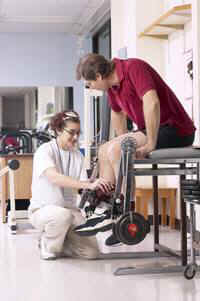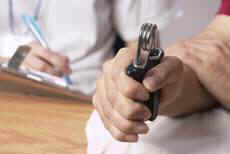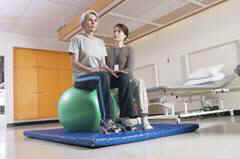Patients are often discouraged to hear that they might need rehabilitation, even though it can really be a very positive thing since it can greatly accelerate the patient’s recovery. It is difficult to provide a single description of brain surgery rehab since it will vary greatly from patient to patient. In this section we will attempt to give an overview of rehab and some of the issues that patients and families might experience. The deficits each person will experience after a bleed or after surgery vary greatly based upon the location in the brain, the condition going into surgery as well as the success of the surgery. Even patients with seemingly similar angiomas report different types and severity of deficits. If a patient is left with a deficit that would restrict their quality of life or their ability to care for themselves or to work, they will likely be provided with rehabilitation. Rehab can take many forms but generally there are four ways that it can be delivered.
During the hospital stay
Most hospitals today have rehab specialists on staff. Often, this will be limited to the basic rehab disciplines of physical therapy (PT), occupational therapy (OT), respiratory therapy and speech therapy. Although some hospitals share their therapists between in-patient and out-patient practices, therapists on staff with hospitals typically are very strong at dealing with those first few days or weeks of a patient’s recovery because this is what they see most. They will often come to a patient’s room and perform an evaluation shortly after surgery to determine if any therapy is required. If so, they will visit the patient’s room on a regular schedule to help the patient begin the process of therapy. Because this type of session is most often one on one, the amount of time the therapist can spend with each patient will likely be limited to less than an hour per day. Hospitals are simply not set up for longer term (and more intense) therapy. Once a patient does not require hospital care they are typically either sent home or to a dedicated rehabilitation facility.
Inpatient Rehabilitation Facility

If the patient recovers to the point that they no longer need the level of care provided by a hospital but they are still not capable of living unassisted, they will often be sent to an inpatient rehabilitation facility. These rehabs offer rooms that are often similar to a hospital room and many times are connected to a hospital, but they are geared completely toward rehab. Because the level of medical care is typically not as robust as a hospital they are lower cost and therefore offer the opportunity for longer term rehabilitation than the average hospital where beds are at a premium. Various rehab facilities specialize in different types of recovery so it is fair to ask what options are available and to understand which would be best suited to working with brain surgery recovery. Often a good indicator is a facility that deals with stroke recovery since it is more common than brain surgery but requires many of the same skills. At an inpatient rehabilitation facility, the patient will typically get a much more rigorous schedule with several group classes and individual sessions per day. Because of this and because the therapists here are likely to be very experienced, rapid progress can be made in a good inpatient setting. Patients will wear their own clothes: sweat pants and t-shirts or sweat shirts during the day because of the gym-like atmosphere.
During the stay at an inpatient rehabilitation facility, the physician that is in charge of patient care is often a physiatrist. A physiatrist is a physician that specializes in physical medicine and rehabilitation. Their focus is on restoring function to patients. Some common areas of specialty for a physiatrist are sports medicine, pediatrics, geriatric medicine and brain injury. The physiatrist may treat the patient directly, such as prescribing any needed medication, or may lead an interdisciplinary team that is treating the patient. The physiatrist may meet with all of the different types of therapists that are treating the patient at periodic intervals such as once a week, to determine the patient’s progress, and to assess continuing and evolving needs. This group, led by the physiatrist, will make recommendations as to how to treat the patient as well as when to release the patient from rehab.
Outpatient Rehabilitation
Once the patient has recovered enough to go home from either the hospital or the inpatient rehab facility, they will often be given some amount of outpatient rehabilitation. This is most often provided at a rehabilitation facility that the patient will travel to a few times a week but it can also be in-home. The trade off between the two is that although in home is more convenient, often insurance will cover more visits at a rehab facility due to lower cost and the rehab facility will often have better equipment and skills than in home care. One advantage that opens up to a patient once they reach outpatient care is that there will often be a wider variety of types of rehab than might be within a given hospital or rehab facility. The patient might seek out specialists in balance therapy, vision therapy and other “boutique” rehabs that could be especially useful to the patient.
Ongoing Maintenance
Insurance normally will pay for a limited amount of therapy. It is often governed by progress reports from the therapist which indicate that the patient is still making progress. At the end of that therapy, it is not unusual for the patient to be left with some exercises that can be done on his or her own for long term maintenance. If the patient’s deficit is with walking for instance, there might be trunk and leg strengthening exercises that the patient can do that will help them maintain the strength to overcome their deficit.
There are too many types of rehab to list here but some common types of therapy include:
Physical Therapy

This is a very broad category of therapy that involves most strengthening and coordination work designed to overcome any physical weakness that the patient is left with after surgery. Physical therapists, for example, work with patients who have had hip or knee replacements to increase their strength and flexibility so that they can walk again.
Although brain surgery does not directly affect the muscles and joints in the same way that a hip replacement does, it can require much of the same recovery for two reasons. First, anytime a patient is immobilized in a hospital bed for some time they lose strength. If that immobilization is extended the patient may need some PT to get strong enough to safely go home. More common for brain surgery is that the control of some muscle or set of muscles is weakened for neurological reasons. Put simply, the muscle is healthy but the neural pathway (the nerves or areas of the brain that control the nerves) are damaged in some way. It is not unlikely that a neural pathway can be damaged but not destroyed; therefore, the muscles affected seem to be dramatically weakened. This can be thought of as the brain just not being able to “get enough of a signal” to the muscle to fully activate it. In these cases, therapy can be very effective at exercising that pathway and helping it to become more useful. This is the same process that a stroke patient will go through. In many cases PT will also include balance, coordination, gait training and overall strengthening. It is very broad by definition.
Occupational Therapy
OT will focus very specifically on the needs of the patient to be able to work as well as daily living tasks such as grooming and household care. If a patient had a weakness in the fingers for example, an OT will evaluate the ways in which this patient needs to use those fingers in their daily life and work and will help them to adapt. OT is a combination of rebuilding the deficits and finding workarounds to allow the patient to continue to perform the needed task. OT might prescribe adaptations to the patient’s home or work environment such as handrails, modified shower, lowered counters, etc. Typical inpatient facilities have kitchens, bathrooms, and work environments in which they help the patient practice the life skills that they will need.
Speech/Swallowing Therapy
If there is a weakness or deficit with the mouth or throat, it can manifest itself as a lack of clear speech or a slow or weakened swallow. Speech therapists specialize in these oral deficits and provide exercises that will strengthen the specific muscles that are slow or weak. Speech and swallowing are amazingly complex activities that require a great deal of coordination in all these oral muscles. Speech therapists can use a combination of observation and imaging diagnostics such as moving x-ray that allow them to understand and treat these conditions.
Balance Therapy

Brain surgery has the potential to affect a patient’s balance. Some PT’s specialize in balance or what is often called vestibular rehabilitation. Balance therapists are skilled at retraining the brains ability to interpret and react to the balance related signals that it gets from the inner ear, eyes and feet. It is physical therapy focused on the patent’s balance. Some patients will have a problem with vertigo as well as balance. Balance therapy will address these issues.
The American Physical Therapy Association website provides a great deal of information about balance therapy including patient handouts.
Respiratory Therapy
Since the brain controls breathing and since surgery carries with it some risk of respiratory complications, it is likely that a patient will at least be evaluated by respiratory therapists during their recovery. The University of Pittsburgh offers a helpful video about pediatric respiratory therapy. Adult respiratory therapy is described by Bella Vista Health Center.
Neuropsychology
Neuropsychology deals with cognitive processes of the brain including, but not limited to, short and long term memory, concentration, attention, problem solving and abstract reasoning. Don’t confuse this with psychotherapy – it is not “counseling”. Neuropsychologists will give a battery of standardized tests to determine neurological deficiencies, if any. Note that these tests cannot take into account the patient’s cognitive level prior to surgery. However, testing may determine the patient is functioning below average in specific cognitive categories and help them to understand and improve on their deficiencies. Also, this information may be very important in determining the patient’s ability to return to work and/or if the patient qualifies for disability. The National Academy of Neuropsychology offers a patient information page (PDF format) that provides more detailed information about neuropsychological evaluations.
Vision Therapy
Vision therapy is for your eyes, just like physical therapy is for your body. When a body part isn’t functioning correctly, we attempt to bring it back into full use with exercise and retraining. In the case of a turned eye or an eye lacking in mobility, vision therapy can help:
- strengthen the muscles controlling the eyes
- speed the time it takes for the eye to return to the regular position
- teach the eyes to work as a team again (just because an eye goes back to its proper position, doesn’t mean the eyes will automatically work together as a team again)
With a turned eye, the use of prism glasses, with slowly decreasing prescriptions (lessoned every 6 weeks or so to make the eye work back to its proper location), along with vision therapy can be a helpful combination to keep the patient using the problem eye (rather than turning it off and only seeing with one eye). It is important to start vision therapy as quickly as possible so the muscles in the affected eye stay strong. The Neuro-Optometric Rehabilitation Association provides many additional articles about stroke/brain injury and vision implications as well as a vision therapist locator.
Thoughts on Therapy

Physical Demands
Rehab can be extremely hard work. This is particularly important to remember given that the patient has just had major surgery and is trying to recover form the surgery itself. The added challenge of overcoming any deficits is a difficult one in some cases. Inpatient rehabilitation in particular can be extremely demanding physically and mentally.
Preconditioning
Surgery is a physically draining process so if it is elective and time/ability permits, it is recommended that you build your strength and stamina prior to the operation. You would be surprised how quickly your stamina can diminish when you are in a hospital bed so it is always a benefit to get in the best shape possible prior to starting this process and not knowing exactly the outcome.
Mental and Emotional Aspects
Rehab can be very difficult emotionally. A patient undergoing brain surgery will understandably be focused on the surgery as the major event. When the surgery is over, it can be very draining to find that there is still a great deal of hard work to do in rehab. It is like running a marathon then at the finish line finding out that there are a few more miles to go. It is possible for progress to seem slow and this can lead to depression. In the movies, characters will “knuckle down” and rebuild themselves but in real life you don’t get to fast forward. It is not unusual to have some “temporary” additional deficits right after surgery that will go away in a few days or weeks, but overall the brain makes a slow but steady recovery. The downside is that it can seem excruciatingly slow at times but the good news is that the brain can continue to make gradual improvements for years. This slow progress can be very frustrating at times.
Another emotional factor is simply the loss of independence. Regardless of how minimal the deficits are after surgery, the patient will no doubt be dependent on other people to help them as they recover. This loss of independence can be very frustrating for the patient. The corollary to this is that when the patient regains their independence, if this time has been long, it can be stressful for them to be on their own again after getting used to the constant support of friends, family, doctors and nurses.
How hard to push
For each person, the decision on how much the support person can or should push the patient in their recovery will be a difficult and individual one.
Visitors
While visitors can be a tremendous boost for the patient, they can also be so draining that it is actually a detriment to the patient’s recovery process. This is particularly true in the hospital and inpatient rehabilitation settings. If the patient is not able to make these decisions the caregiver must assist with this, and may need to limit visitors to less busy times or days depending on the needs of the patient. Especially in the inpatient rehab setting the 15 minute rest or nap between therapies may be more beneficial to the patient than using that energy to talk to visitors. This again will depend upon each individual situation and will vary greatly.
Insurance
Insurance will qualify for a number of sessions or until a certain level is achieved. Most therapies have measurements to determine where the person is in their recovery and this information is relayed to the insurance provider.
The role of surgeons in rehab
It is natural to have great respect for a brain surgeon, especially if they have just completed your operation. It is important to remember that although the surgeon has immense knowledge about your surgery, they are likely to have little practical experience at rehabilitation. Many times your questions to your surgeon about recovery will not be clearly answered. Rehab therapists do not have the status in most people’s minds that a brain surgeon has, but they often are an enormous source for information about recovery beyond the hospital. As good as surgeons are at surgery, they do not have the experience that therapists have of spending their days watching and helping patients recover. If you have deficits after your surgery, you should search for the most qualified rehab people you can find because they can make a huge difference in how quickly you recover.
Duration of rehab and recovery
This is often first question people ask. The length of rehab and recovery are specific to each individual. A patient may bounce right back or may be left with a long term deficit. The bad news is that it possible to have a deficit for a long time because the brain heals slowly; the good news is that the brain continues to heal for a LONG time. The important thing is to not give up hope – research has shown that motivation and a positive attitude are the things that differentiate those who continue to improve versus those who reach a plateau and do not move past it.
This page last updated 5.28.20
This page is not a substitute for competent medical advice. It is for informational purposes only.

